13+ Sample Company Emergency Action Plan
-
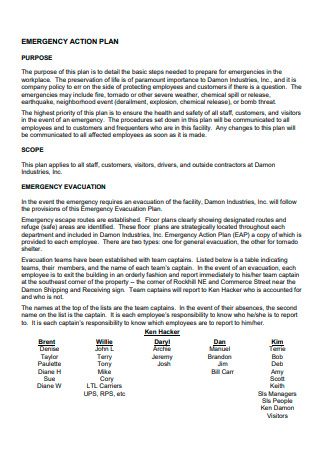
Company Emergency Action Plan Template
download now -

Sample Company Emergency Action Plan
download now -

Company Job Site Emergency Action Plan
download now -
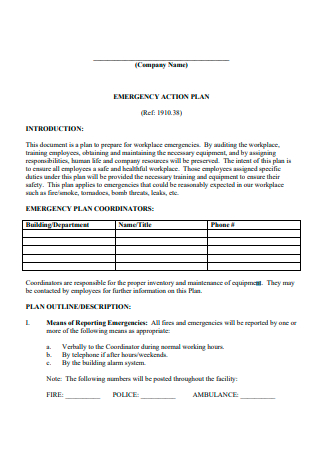
Company Emergency Action Plan Example
download now -
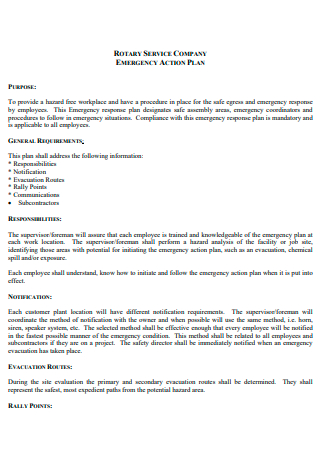
Service Company Emergency Action Plan
download now -
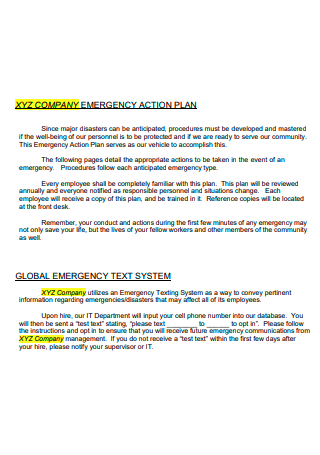
Printable Company Emergency Action Plan
download now -
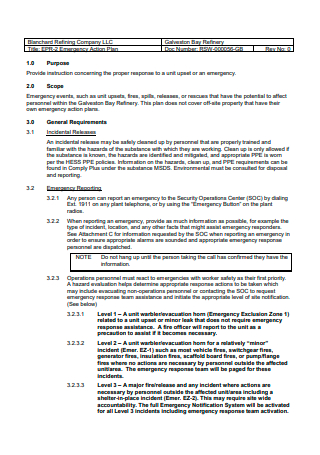
Company LLC Emergency Action Plan
download now -
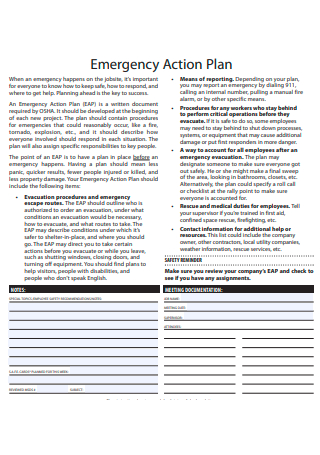
Company Emergency Action Plan Format
download now -
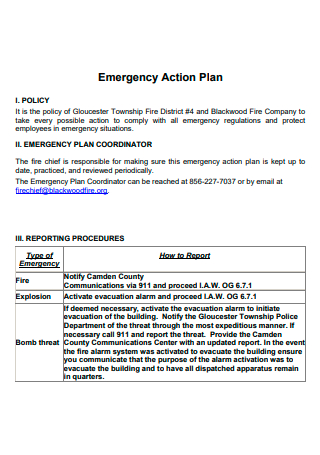
Company Emergency Action Plan in PDF
download now -
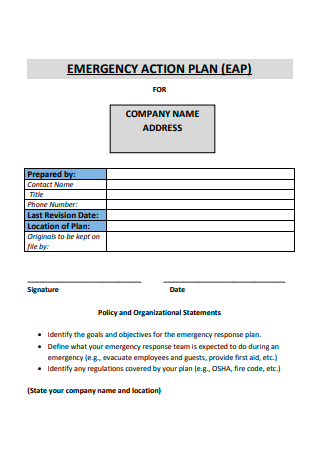
Basic Company Emergency Action Plan
download now -
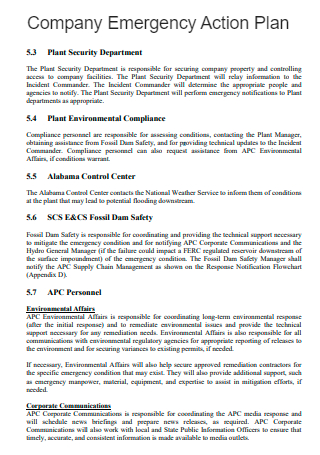
Simple Company Emergency Action Plan
download now -
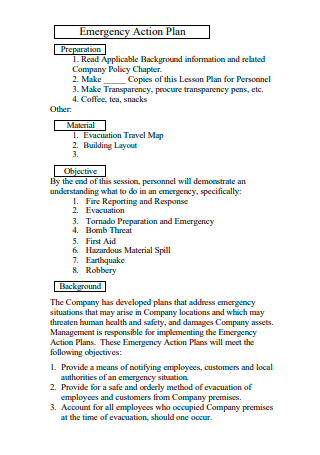
Draft Company Emergency Action Plan
download now -
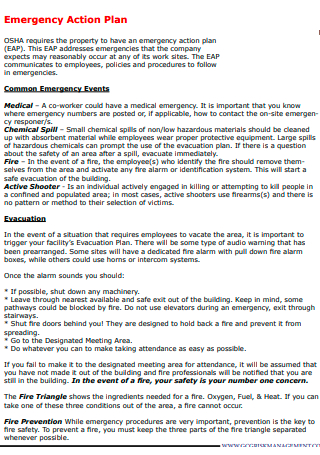
Formal Emergency Action Plan
download now -
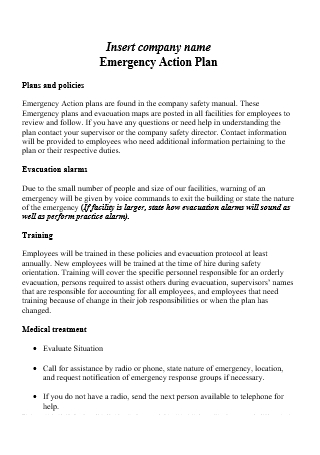
Company Emergency Action Plan in DOC
download now
FREE Company Emergency Action Plan s to Download
13+ Sample Company Emergency Action Plan
What Is a Company Emergency Action Plan?
The Essential Elements of a Basic Emergency Action Plan
How to Create a Winning Company Emergency Action Plan
FAQs
What is the difference between EAP and ERP?
What are the three main sections of the EAP’s components?
What are the three steps in the emergency action plan?
What Is a Company Emergency Action Plan?
The company emergency action plan (EAP) is a detailed step-by-step process on the standard responses given to different kinds of emergencies or workplace emergency situations. So when it comes to detailing your organization’s appropriate safety procedures, you can’t forget about EAP. And having this business emergency action plan and training your company members about it can help a lot for your company. So in facing a certain emergency, you can lessen the chances of injuries, damages, and other harmful effects.
The 2003 National Incident Management System implemented that the state, federal, and local entities worked together for disaster responses. Thus, hospital emergency plans improved compared to the 9/11 catastrophe and the recent COVID-19 response.
Also, the Occupational Safety and Health Administration (OSHA) requires emergency action plans that go according to their standards.
Why Is a Company Emergency Action Plan Important?
Company emergency action plans are essential as they are lifesavers. Rather than being in a state of shock and not knowing what to do in dealing with emergencies, an action plan lets you respond to such circumstances smoothly. For example, you can base on the plan whether to fight or flee from a dental office fire, where to evacuate from a storm, and even in assessing if your company’s floor plan can withstand earthquake conditions. So take this opportunity to plan in reassuring that your employees, equipment, and overall business still survive during emergencies.
Also, it is critical to point out that emergency action plans are required by OSHA. And these written plans better follow the OSHA standards and requirements. Because if anyone creates the EAP without quality standards, who knows if the employer and employees actually followed a reliable response in face of an emergency? And emergency action plans even involve training to ensure that members or employees know what their responsibilities are. Thanks to well-written EAPs, fewer chances of confusion, injuries, damages, and disorganization in responses take place.
The Essential Elements of a Basic Emergency Action Plan
You already know what a company emergency action plan is and how important it is. But do you already know what underlying elements are inside a standard emergency action plan? Although EAPs aren’t the same for every organization because of polarizing building structures, personnel number, and operation hours, there are common factors expected in most EAPs. In this section, you’ll learn about the elements of an emergency action plan aka what to include in your final printable emergency management action plan.
How to Create a Winning Company Emergency Action Plan
Are you ready to make your own company emergency action plan? Rest assured, you will get the hang of it soon. And even if it takes plenty of time and effort to perfect it, the results will be worth it as it’s for the good of your organization. So no matter what form of company you deal with, here are the universal steps to craft a proper company emergency action plan:
-
Step 1: Pick a Sample Template to Optimize
Here at Sample.net, you’re given free access to all sorts of editable templates, including a printable emergency action plan template. Also, you can explore other samples besides a free emergency action plan template. Examples include a general business plan, Contingency Plan, and strategic plan. And the best part is you can design, format, or edit your sample template however you like. So there’s no need to stick with a basic example because there is room for improvements and additional ideas.
-
Step 2: Study Your Company
Bear in mind that different companies should never use the same emergency action plan. So it is crucial to study and research your company’s data. That means you refer to the workplace Floor Plan, the number of employees, passages to emergency exits, and others. Whether your business is related to aviation, medical service, retail, or any industry, knowing more about it lets you create a much better EAP. Just like needs analysis templates, this will help you understand what’s appropriate for your EAP.
-
Step 3: Collaborate with Team Ideas
A collaborative effort is always welcome. For example, hear out some recommendations from your team members. There’s no need to base wholly on your perspective because sometimes you could be wrong with your decision. And it is through that collaboration that you don’t only make everyone feel heard but also get to discover better factors for the emergency action plan. More so, collaborations make people participate. Thus, people get updated about what’s what on the company emergency action plan.
-
Step 4: Set High-Quality Standards
You already know that OSHA standards are encouraged and they are there to ensure that top-quality standards remain on your EAP. But, you can also work with other EAP experts as you can learn a lot from them. Keep in mind that emergencies could lead to property damage or even a serious injury. So it’s nothing to be taken for granted. And the best way to maintain standards is to insert the eight elements of a company emergency action plan, which was discussed earlier. From evaluation measures to EAP Policy And Procedure updates, these aspects can make a huge difference to your organization.
-
Step 5: Organize Your Writing
Of course, writing the rules, instructions, and data must be clear and thorough. You can double-check your writing afterward to ensure that your EAP Document is error-free in the end. Also, make the statements easy to follow. That means you keep messages straightforward so as not to confuse whoever is reading the plan. Let go of vague and flowery words since those are not going to make the plan any better. Once you are confident of the EAP’s output, then be sure to print and share it with the team.
FAQs
What is the difference between EAP and ERP?
An emergency action plan (EAP) highlights the company staff’s safety towards onsite incidents including fires and medical emergencies. Meanwhile, an emergency response plan (ERP) takes a similar route but it delves more into the development of processes. That way, it helps people realize how a certain emergency could impact them.
What are the three main sections of the EAP’s components?
You already know that there are eight elements of the emergency action plan. But those components are actually categorized into three different sections. And the difference lies in where the emergency occurred and other health and safety scares. Hence, the three main sections of EAP’s elements are the emergencies inside the building (such as fires and power outages), emergencies outside the building (such as lightning and hurricane), and health-related emergencies (such as a heart attack and concussion).
What are the three steps in the emergency action plan?
A simple emergency action plan can be made in just three basic steps. These are (1) to acknowledge the evacuation processes and escape routes, (2) to set clear communication in the chain of command during emergency responses, and (3) to account for the whole team after the evacuation. And these examples make up a solid company EAP.
With the recent COVID-19 pandemic, continuous climate changes, and other nefarious possibilities, don’t wait for the worst-case scenarios to occur. Prepare a strategic plan! Think about the survival of your organization from threats including fires, storms, floods, etc. For the welfare of your business, always stay armed with a well-thought-out company emergency action plan. Download a sample template now!
